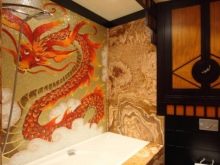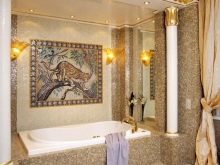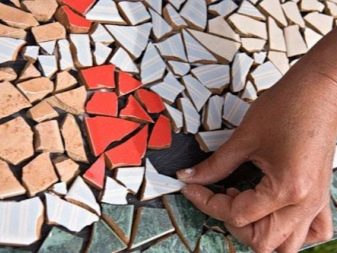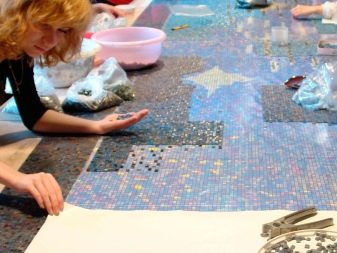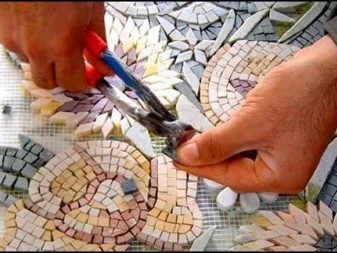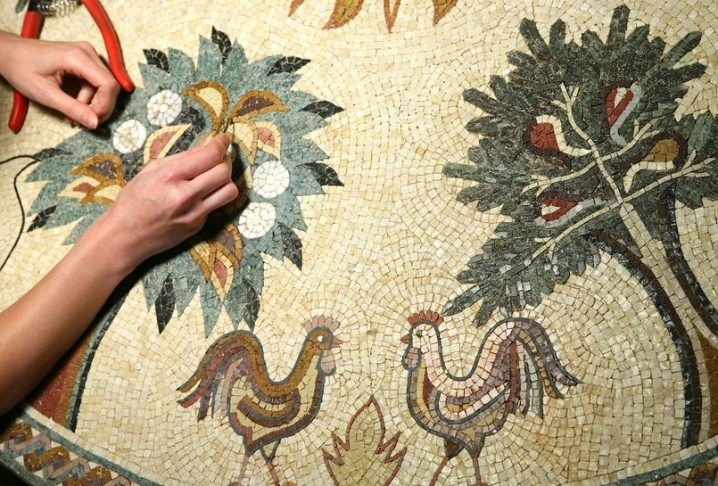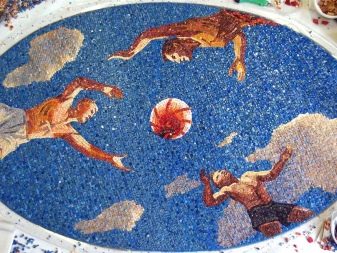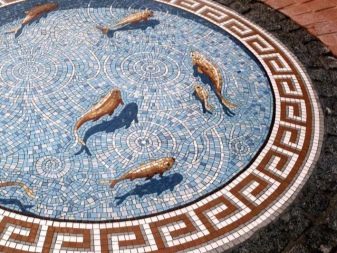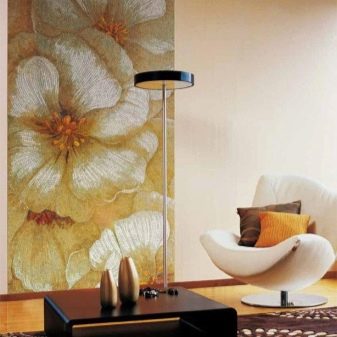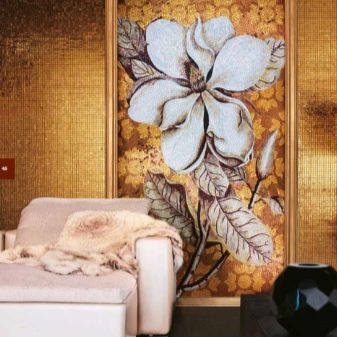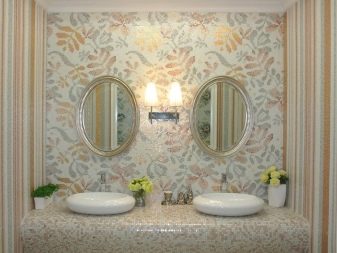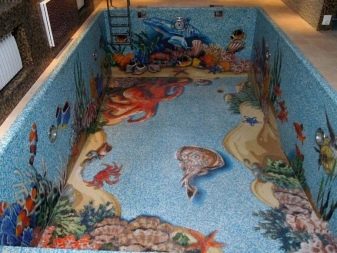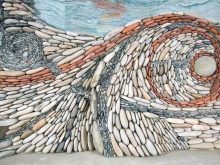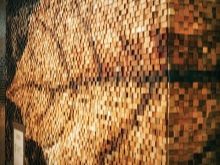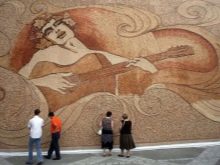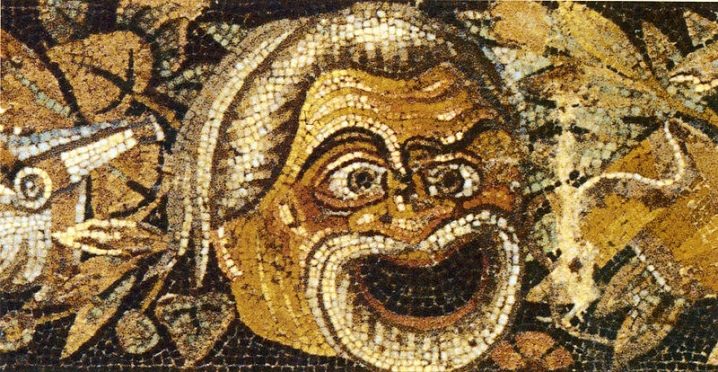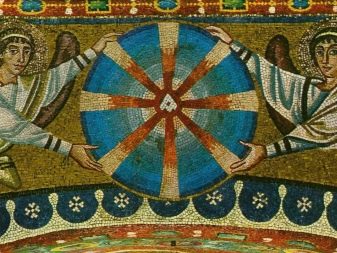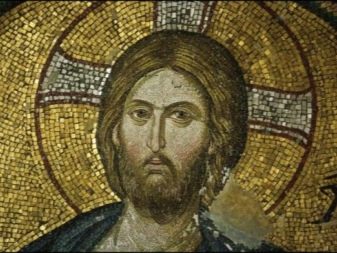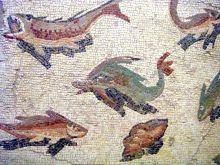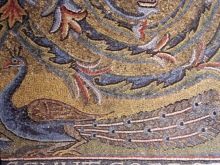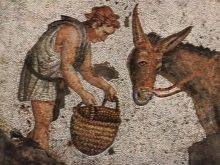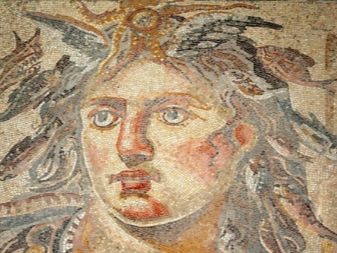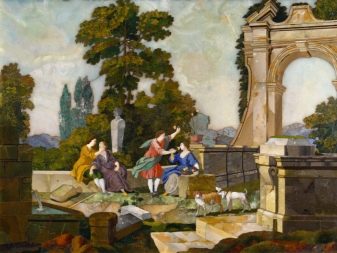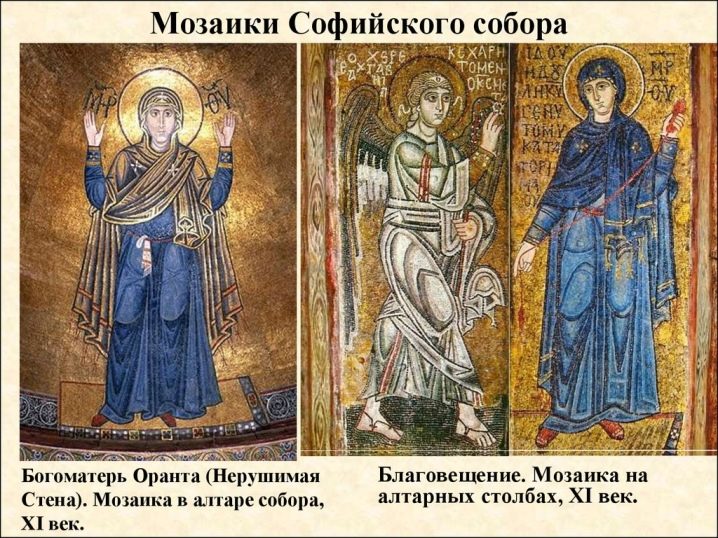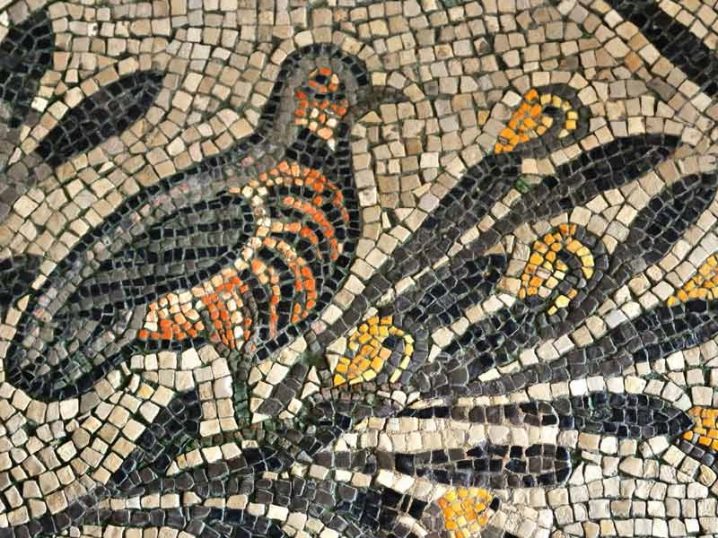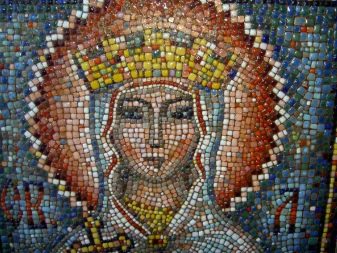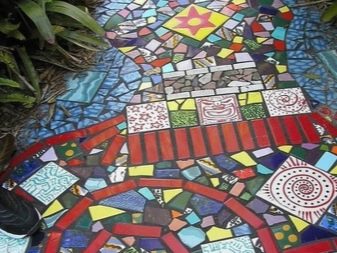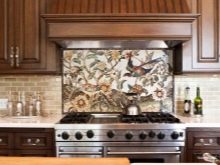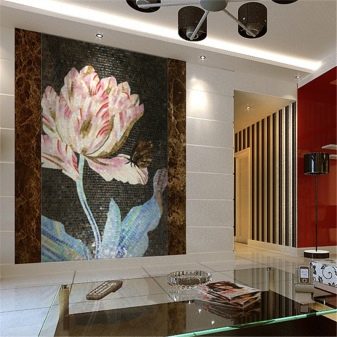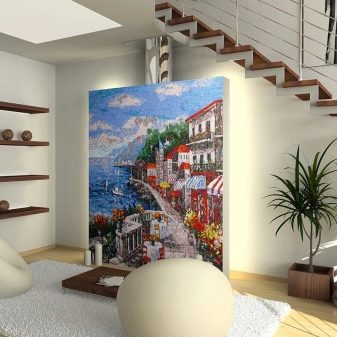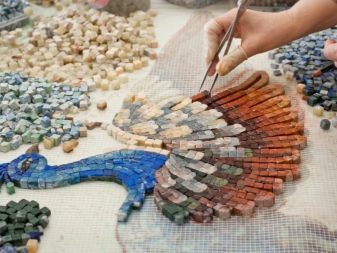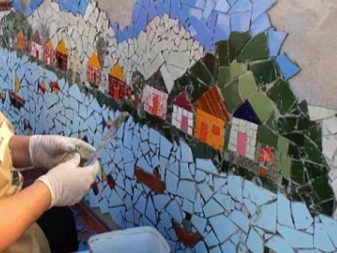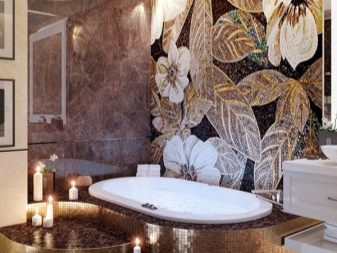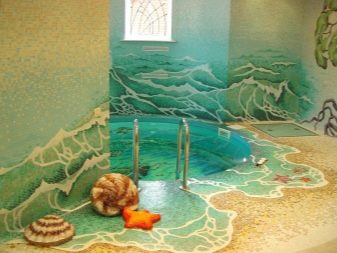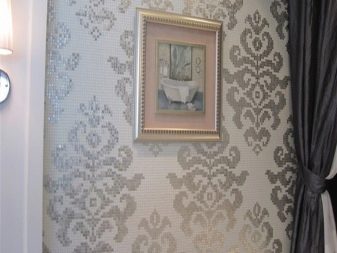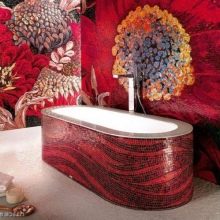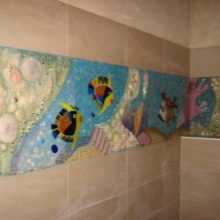Mosaic panel: original interior decorating ideas
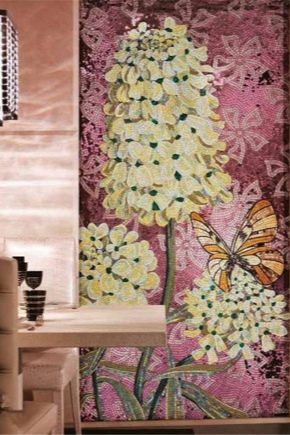
The definition of "mosaic" is called a pattern or ornament, lined with fragments of stone, pieces of ceramic tile or glass fragments. Ancient Greece is considered its birthplace - it was there, as historians believe, that they first began to decorate the walls and vaults of temples with colored pebbles. Later, this type of activity began to be adopted in different countries, with each nation bringing something of its own to it.
Special features
There are two ways to create a mosaic - direct and reverse.
In the first case, the fragments of the future product are laid out on the surface with the finishing side up.This technique is used for laying out mosaic panels on flat horizontal surfaces. All fragments of the future picture are put on glue on a special mesh. Then the grid is transferred to a permanent place of stay, and then overwritten the seams.
If the surface of the mosaic application has a curved shape, apply the reverse installation. Most often, this method of laying is used if the basis for the composition is fabric or cardboard. The tile is glued onto the base face down, then the base is made - the entire composition is held together with a special solution. When the base hardens, the paper or cloth is removed from the front. Grouting is done on site.
Today, several technologies are used to create mosaic panels:
- Matrix technology It is considered the easiest to manufacture. Mosaic elements are assembled into finished prefabricated fragments on a paper or net basis measuring approximately 30 cm. In the shops, you can buy ready-made compositions consisting of such fragments, and you will only have to fix them in a certain order in place using special glue. They can be monotonous,and multi-colored depending on the idea of the artist and scope. Their shape is most often square or rectangular, less often other forms are found.
- Art technology It is used mainly when performing exclusive orders on individual sketches. This is a very delicate, painstaking handicraft, comparable to hand painting - with the help of this technology it becomes possible to recreate entire paintings and even portraits. For this, both whole tiles of regular shape and their parts can be used - the smaller the mosaic elements, the higher their artistic value and, accordingly, the cost. Artistic technology helps to focus on the various elements of the finish or, conversely, to hide any imperfections. In order to enhance the aesthetic properties of the finished product, an artistic grout is applied - a suitable color range is selected for each piece.
- Mixed technology - its name speaks for itself. It combines some elements of manufacturing the first two technologies. Through this approach, you can achieve high quality and save on some stages.works
Mosaic tiles are very capricious in their work, it requires scrupulousness and great patience.
Manufacturing materials
Depending on where the decorative panel will be located, different materials can be used. Floor coverings should have a special endurance, abrasion resistance and should not slide, so the patterns on the floor lay out mainly of stone, which has a matte non-slip surface. Modern manufacturers offer a wide range of marble, granite and other tiles for mosaics made of natural stone. Also for the floor is often used ceramic tiles.
You can put whole works of art from punctuated small details. not only for the floor, but also to decorate the walls. For this fit not only marble or ceramic tiles, but also glass. Unlike stone tiles, a mosaic of cracked glass has a very beautiful brilliance and a beautiful play of light.
One of the varieties of glass tiles is smalt - it has high strength, attractive glossy shine and excellent color reproduction.Smalt is often used to decorate the arches of temples, palaces of culture, theaters and other public institutions. From it often lay out the whole picture, while the tiles themselves are typed by hand. To obtain a special color rendition, special dyes are added to the glass, and thanks to high technology, thousands of different shades of different colors can be obtained. Today it is even possible to obtain gold and mirror smalt, which looks very unusual and expensive in the interior.
Classical smalt is produced by breaking off small pieces from a large whole formation. Punched pieces are obtained irregularly shaped and dissimilar. This is their main advantage. The factory smalt has some similarities with ordinary glass mosaic, only the quality of the modules is much higher. These two types often combine with each other when finishing one interior. When finishing the interiors of rooms with high humidity, such as a swimming pool, hammam or bathroom, most often combine several types of different smalt.
For the design of various columns and other surfaces with complex shapes are often used metal mosaic.It looks very impressive, as well as durable and unpretentious in the care. Steel and aluminum are most commonly used to make it. From these materials, various imitations for gold or platinum are created.
Modern technologies allow to create mosaic canvases from a wide variety of materials. For these purposes sea pebbles, wooden bars, fragments of bottle glass, cork are perfect.
Sometimes the most unexpected materials can be used - for example, sawdust and even plastic film.
Style and design
The mosaic spread across the globe, and every nation added something of its own to this kind of art, peculiar only to this nation. Today we can distinguish several styles. Consider some of them in more detail.
Alexander mosaic appeared in the IV century AD. It got its name in honor of the great commander Alexander the Great and portrayed episodes from his campaigns. The color palette is dominated by several natural shades - it is red, red-brown, white and yellow. Figure characteristic of this style, laid out strictly on a certain border.Mosaic elements were carved from marble or glass, and polished in a special way. At the same time, they never went beyond the designated limits.
Byzantine mosaic appeared around the 6th-7th centuries. and has not lost its relevance to this day. It is highly valued and easily recognizable due to some of its features.
First, it is laid out of smalt - it is Byzantium that is considered its homeland. Secondly, it is necessarily a golden background. For different shades mixed several types of metals in different proportions. It can be copper, mercury and even gold particles. All depicted objects have perfectly clear contours and correct proportions - the elements have the shape of a cube. Therefore, near the picture seems somewhat rough and revealed in all its glory only from a certain distance.
Classic examples of scenes depicted with the help of a Byzantine mosaic can be observed in many temples of Italy, preserved from ancient times. Today, in this technique, you can upload absolutely any pictures. These can be mythical animals like dragon or fantasy flowers.Not bad looks in this style and the marine theme - fish, dolphins, coastal landscapes.
Florentine mosaic named after the eponymous city of Florencein which she first appeared. It is made from natural stone - most often from sea pebbles, and is considered one of the most complex in execution. Florentine style is characterized by laying the elements closely, leaving virtually no space for joints and grouting. And since all the fragments from nature have the most diverse shapes and shades, then fitting them together is a very laborious process.
Mikhailovsky mosaic originated in the Middle Ages on the basis of the Byzantine school. In the described technique, all shades of green and gold prevail. The plots of the mosaic are mainly biblical - in this technique the Hagia Sophia in Kiev is painted. Due to the various shades, the image is not static, but lively and interesting, for which this style is valued all over the world.
Sofia mosaic has a more diverse color palette.than the previous school. For this mosaic, pieces of smalt of various shapes were used - square, oval and even triangular.In this case, they did not fit as carefully as the Florentine masters did.
Roman mosaic is also laid out from smalt. It uses very small pieces, which allows for high accuracy of the picture. This technique is especially good for depicting people, natural landscapes, as well as various representatives of flora and fauna. Thanks to this technique, it is especially well possible to transfer flowers and animals in motion.
Russian mosaic is made of stone. Its advantage over other styles is that such a mosaic can be created on curved surfaces on which it is impossible to apply classical technologies. In the Russian mosaic technique, you can make small crafts such as caskets or writing instruments. Its essence lies in the fact that the very basis of the future picture is created from durable, but not very expensive stone, on which plates of semiprecious stones about 5 cm2 in size are pasted on top.
For these purposes, they usually use malachite, agate, lapis lazuli and other stones that have a beautiful texture.
Scope of application
You can decorate any surface with a mosaic pattern.Usually, mosaics decorate walls and floors both indoors and outdoors. Sometimes in this way decorate the walls of houses, and a mosaic path on the garden plot can transform it beyond recognition.
In the cathedrals it can also be observed on the arches. In everyday life, such panels are more often found in the interiors of various premises. Where it is necessary to decorate a large area, the panels are usually laid out of stone or modular elements are used. It is also possible to purchase ready-made composition for the house, which can be glued not only to the bathroom, but also to decorate one or several kitchen walls - for example, a working apron.
Some admirers of this type of art prefer not to confine themselves to decorations in the outbuildings and decorate with mosaic paintings and living rooms. For these purposes, there are also ready-made solutions. And if you want some kind of exclusive, then there are many manufacturers that can create a mosaic canvas according to an individual sketch. For example, a living room with a picture of malachite or a bedroom decorated with a glass panel will look very impressive and unusual.
At the same time, it is erroneous to believe that the mosaic looks good only in large-scale projects. From it you can create small paintings, it can decorate the kitchen countertop or decorate the furniture.
How to do it yourself?
Contrary to popular belief that mosaic is very difficult, such an ornament can be assembled by hand.
The process of creating a decorative panel occurs in several stages:
- Selecting a drawing and creating a sketch.
- Handling sketch. The selected picture needs to be scanned, and then with the help of a special computer program to build the layout of the mosaic elements.
- To decide on the choice of material and fastening solution. If you choose a glass tile to create a mosaic, you need to glue it with special glue recommended by the manufacturer or consultant in the store. Stone and ceramic tiles should be planted with a special solution of cement, glue and water. To evenly apply the solution to the wall or floor, a notched trowel is used.
- Preparation of the base and the solution. The surface on which the future picture will be located must be free from dust and debris.Before sticking tiles, you should make a preliminary marking on the wall.
- It is necessary to glue sheets or fragments of mosaic one by one, not forgetting to insert special crosses between them - spacers.
- Grouting joints. After all the elements of the panel are fixed, it is necessary to seal the joints with a special grout, applying it to the entire area with a rubber trowel and carefully filling all the voids between the tiles.
Excess solution should be removed, and when it dries, wash off all residues with a damp sponge.
Clearly the process of creating a panel is shown in the video below.
Beautiful examples in the interior
The possibilities for applying mosaic technology are almost endless. It can be used in all residential and non-residential premises. The main thing - to choose the right material. So, for example, for a bathroom and bathrooms it is better to choose ceramic tiles with a special protective coating from calcium deposits and exposure to light. This tile is also suitable for the kitchen - it can lay out an apron, flooring or countertop.
If you have conceived to decorate the fireplace, for these purposes it is better to choose heat resistant glass. Mosaics can also decorate sinks, stairs and window sills.You can decorate the walls completely or make a decorative insert. The image will look more original if you skillfully combine materials - for example, glass inserts are used in a ceramic composition.
If the mosaic is on the whole wall, you can create the illusion of a waterfall using tiles of the same color but different shades, which smoothly flow from one another. This decor is soothing and relaxing. If you like bright accents, you may want to look at the shiny tile - gold or mirror. However, such decorations for the amateur and in large quantities can be annoying. But as a fragmentary compositions look very impressive.
The combination of elements with different textures - for example, matte and glossy elements in a mosaic panel - looks originally. It will look differently depending on the angle at which the light falls on it.
Quite bold and unusual will look like a composition with elements of fusing - baked glass. It looks especially attractive in combination with mother of pearl, rhinestones, rock crystal, as well as with smalt and other types of finishing materials.
With the help of mosaics you can lay out not only abstract patterns, but also reproduce canvases of famous masters, as well as create your own masterpieces.

